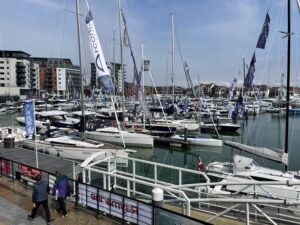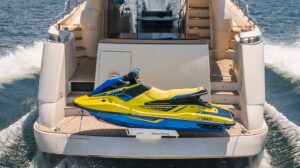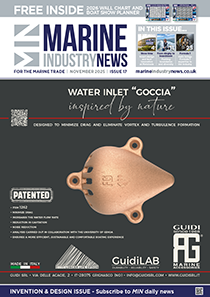In Focus: Preventing death by accidental drowning in marinas, what’s the answer?
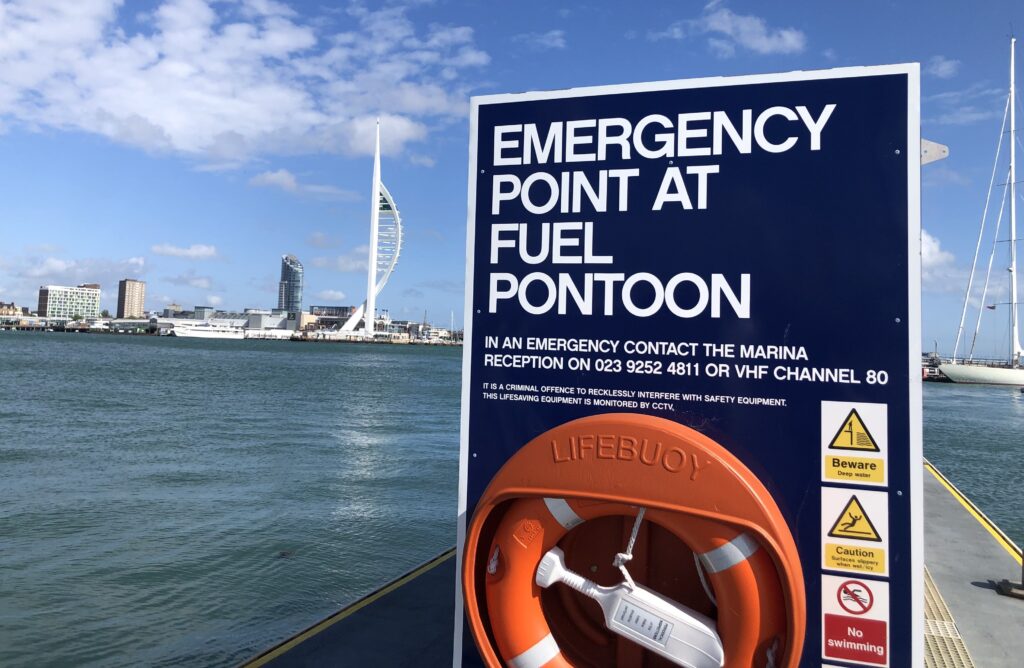
Earlier in April 2023, a woman’s body was pulled out from Thames and Kennet Marina. Officers recovered her body from water and Thames Valley Police launched an investigation, with foul play initially suspected.
Incidents like these, deaths in marinas, are thankfully rare – but they do happen.
Paul Williams, inventor and founder of the Man Overboard Marina Alarm System, says he was inspired to create his system after a lady in the marina where he berthed fell into the water (she was trying to board her boat). This was 2018.
“It took 15 minutes for anyone to hear her cries for help,” says Williams, “and when she was rescued from the water, she was hypothermic and had lacerations to her legs from the muscle growth under the waterline.”
He says the incident made him realise that the issue was not so much getting the person out of the water, but allowing them to raise an alarm.
Accidents in marinas
It was around the same time that Carl Wolf, a marina and boatyard expert with Robson Forensic, published Marina Drownings, Life Rings & Safety Ladders. The book examines his research into people that drowned after unintentionally falling into the water, regulations regarding life rings and safety ladders, and recommendations for best practices. Over his career as an operator and consultant in the USA, he had experienced some drownings and noticed that some operators were resistant to safety ladders and life rings because they often weren’t required (reported Marina Dockage at the time).
Wolf described guidelines, regulations and standards on the use and placement of safety ladders and life rings in the US, as ‘limited and ambiguous’. His (online) research identified 107 marina drownings during 2008 to 2017, of which 85 per cent were male. Victims had fallen into the water in various ways – walking on the docks, embarking or disembarking from boats, working on boats, while docking, being chased by police, from a chair on the dock, and other causes of falling weren’t known.
Wolf recommended creating safe centres with safety ladders, life rings and a floating line, and that a national panel was established to address the issue in the marina industry. He acknowledged that it’s hard for marinas to enforce the use of PFDs among marina customers, but operators have a responsibility to educate their boaters and keep an eye out for unattended children as much as possible. In July 2022 MIN reported that the question of whether it should be a legal requirement for children to wear lifejackets was splitting the industry.
UK embraces safety boxes on pontoons
Concerns around marina safety in the USA were mirrored across the world, but the UK’s Premier Marinas says it was making changes to practice as early as 2009.
“The biggest change we have seen is creating a dedicated role for EHS [Environment, Health, Safety] at Premier,” says Peter Wortley, Premier’s EHS manager. “This began in 2009 and we have been building on our practice and procedures concerning environmental health and safety management ever since.” He says the procedures have really stepped up again in the last three years with the marina chain installing new safety boxes on the pontoons.
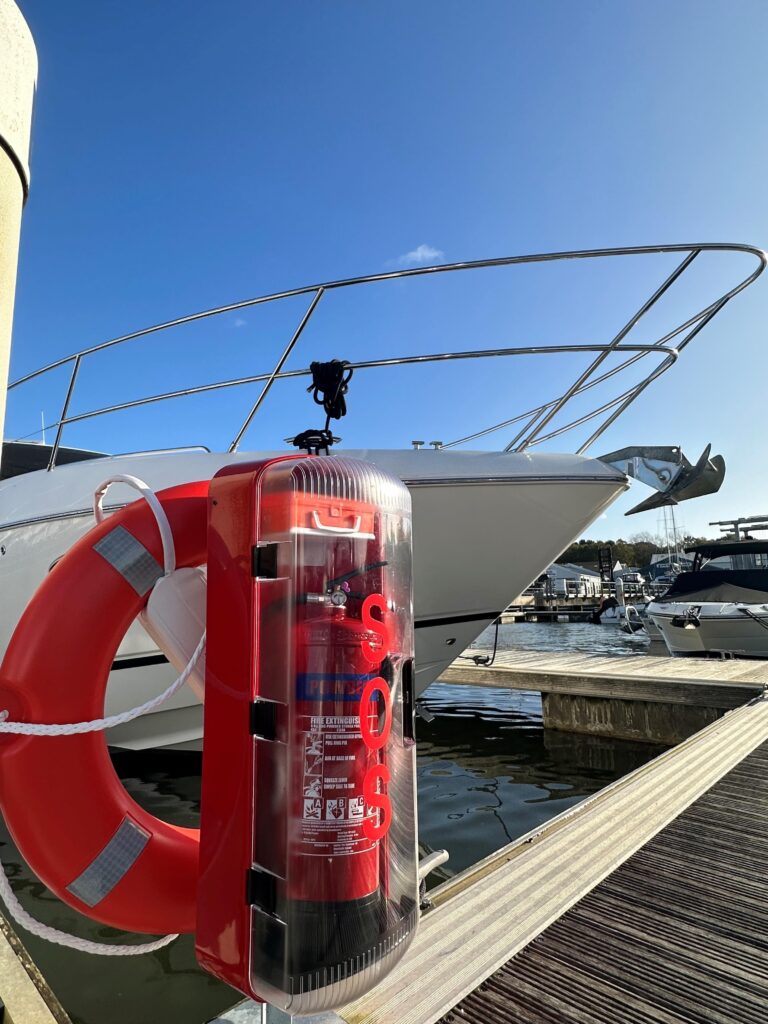
“The boxes house a life ring, a throw rope and a foil blanket. Premier is also in the process of installing long-reach poles across all its sites and it says safety ladders are positioned at strategic points on the pontoons – painted bright yellow for instant recognition. Plus, it’s installed defibrillators at all of its marinas and Wortley says the company ensures it has people on site who know how to use them.
Likewise, Joe Walton, MDL’s head of health, safety and environment, says MDL has operated effective safety systems for many years, and these are continually reviewed and improved. But, he points out: “It appears that people think accidents will not happen in the marina, but this is simply not the case, and although MDL advises best practice and has safety precautions in place with assistance available on site 24/7, it’s important that boat owners do everything they can on a personal level to ensure their safety too.
“Ideally, every person around water, whether working or for pleasure, would follow the same precautions as MDL and our teams. Unfortunately, all too often the only times people consider donning a lifejacket is when they prepare to sail out the marina.”
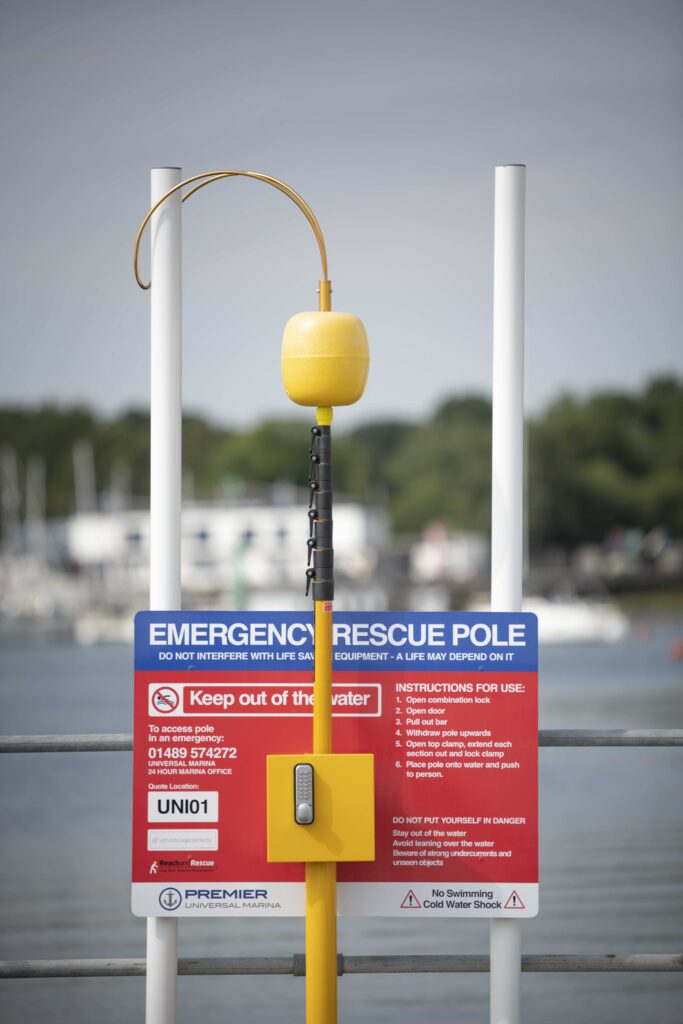
“Whereas we cannot enforce our berth holders to wear lifejackets, we do promote it and we certainly ‘walk the talk’ as all Premier Marinas employees must wear lifejackets when working on the pontoons,” agrees Wortley. “We do promote best practice and host annual safety events at our marinas involving experts who can share advice and equipment checks. Our regular newsletters often share safety advice such as… the RNLI’s [advice] about cold water shock. Should the worst happen, we hope our marina users can draw on this knowledge.”
Walton says there is a combination of safety equipment in place across the MDL sites and that’s coupled with “good working practices and regular training. For example, our teams have received specialist water safety training from the RNLI, and have lone working devices, lifejackets and water recovery equipment along with self-recovery equipment i.e pontoon safety equipment, ladders and life rings.”

To enhance the protection of MDL’s teams, Walton says they’ve implemented “ever improving technologically advanced equipment, for example lone worker devices incorporating ‘man down’ functions, GPS positioning etc. safety and inspection systems offering live inspection and defect data, automatic notifications etc.”
Changing practices in safety at UK marinas
boatfolk says it changed its practices after a member of staff fell into the water while conducting fender and line checks in strong winds. “They were by themselves at the time, but luckily they were spotted and retrieved from the water,” says Tom Ralph, assistant marina manager and health and safety champion at Portland Marina. “After reviewing this incident we introduced a policy whereby during any checks taking place with winds above 25 knots a minimum of two staff members must be present.”
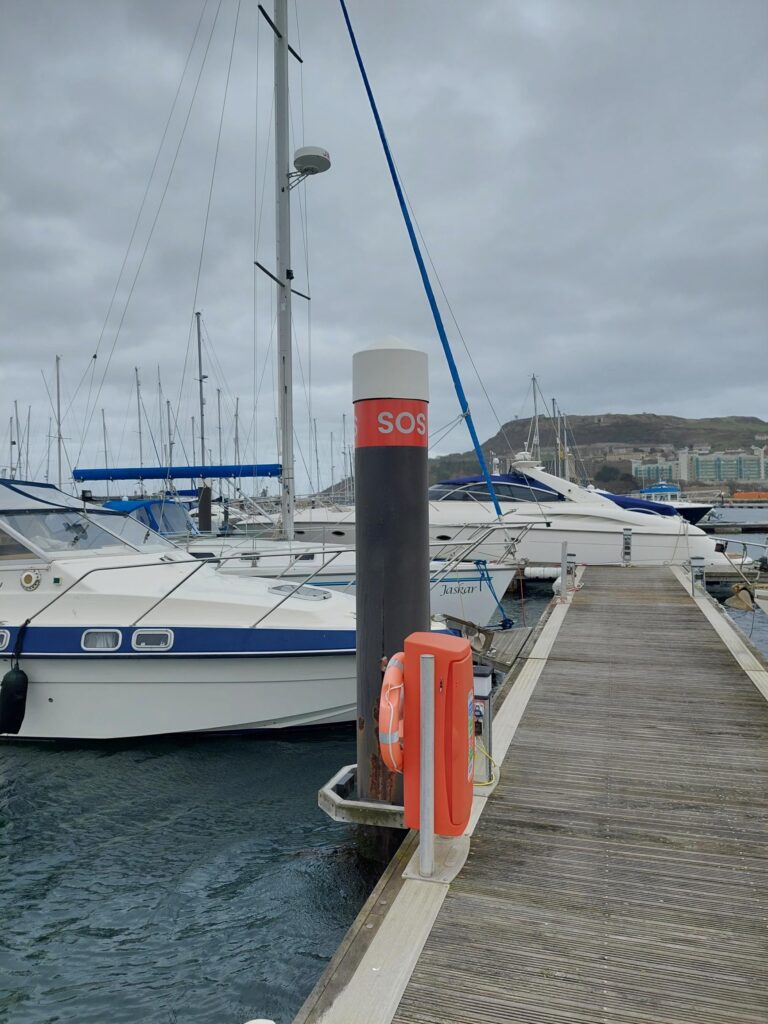
Ralph says all staff are water safety trained which includes “the use of throwlines, life rings and Jacob’s Cradles as well as the different conditions which will affect the use of these methods. We also have clearly identifiable reaching and throwing aids throughout the marina to ensure anyone in the marina can easily find this equipment when it is needed.”
Over the past couple of years he says SOS branding has been added to pontoon piles near the SOS bollards (those contain a life ring, first aid kits and fire extinguisher) to make the location of these more visible for those needing to perform a rescue.
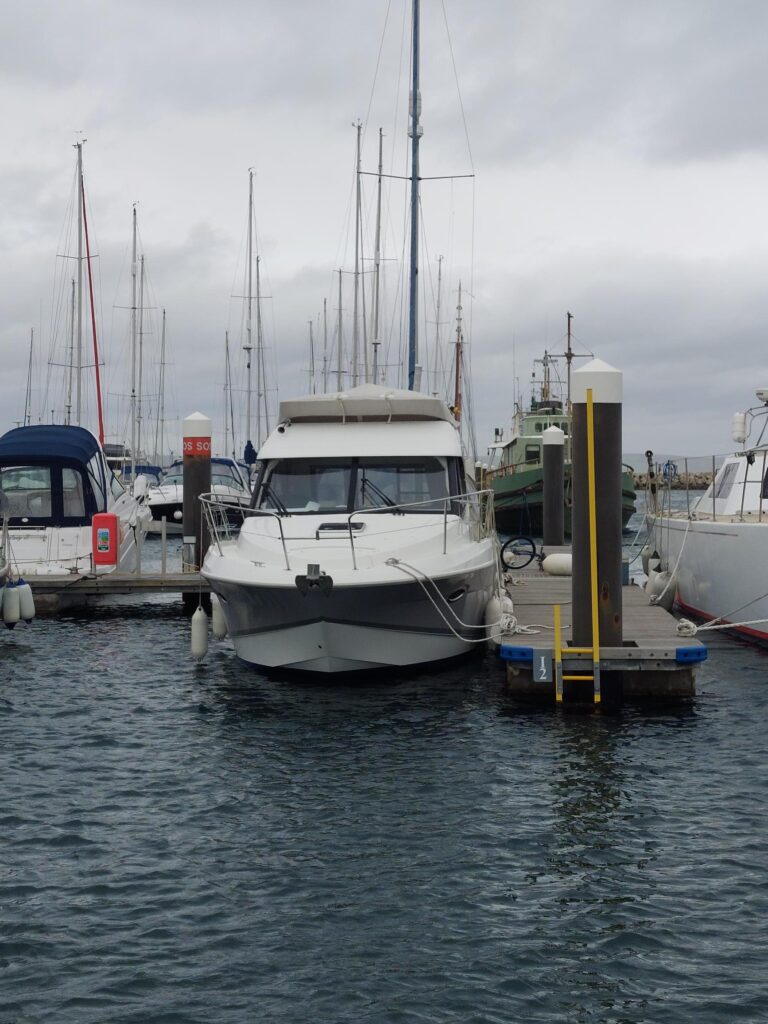
“We have started a phased replacement of safety ladders to introduce those with an extended pole which make them easier to identify from the water or for those directing someone to a ladder,” he says.
Like MDL and Premier, boatfolk staff will always be seen in their lifejackets. “At Portland Marina (and across boatfolk as a whole) we have a lifejacket policy, which ensures that all marina staff wear a lifejacket while on or near the water. We find it important that our team are leading by example when it comes to safety on the pontoons,” says Ralph. “When it comes to areas we can’t control we try to make recommendations, setting the right example (e.g. wearing lifejackets) and educating our berth holders about why we make these recommendations.”
boatfolk also runs awareness days focusing on water safety. These include workshops and processes as well as giving berth holders the opportunity to use throwlines life-rings and Jacobs Cradles. Ralph says there is also videos on using safety equipment as well as guides to where everything is located in the boatfolk app.
Prototype for marina safety in Australia
Meanwhile in Australia, Williams couldn’t let go of what he’d witnessed in the marina and set about creating what he terms the ‘first system of its kind in the world’ designed specifically to give a victim in the water at a marina’s edge a chance to raise an alarm.
After creating a prototype with tech company, Dek Technologies, the system went for trials at Royal Melbourne Yacht Squadron (RMYS) and was put to good use when a 74-year-old man backed his mobility scooter into the water (see 25 seconds into video below). The elderly gentleman successfully activated the rope alarm, and was pulled out in nine minutes.
“I was sitting in my office and my phone pinged advising me of an alert,” says Damien Ryan, from RMYS. “I guessed someone had pulled the cord. Firstly I looked at the marina cameras to see if anything was obvious. My assistant went out on the golf cart – because it sets off a localised alarm it did alert a couple of other people out there on the marina. They found the gentleman, he was unable to extricate himself, so if it wasn’t for the other guys, the result would have been very different. The system worked perfectly, exactly as it was designed. There was no one in the immediate vicinity, no one heard the splash. If it wasn’t for the system, no one would have known what was going on.”
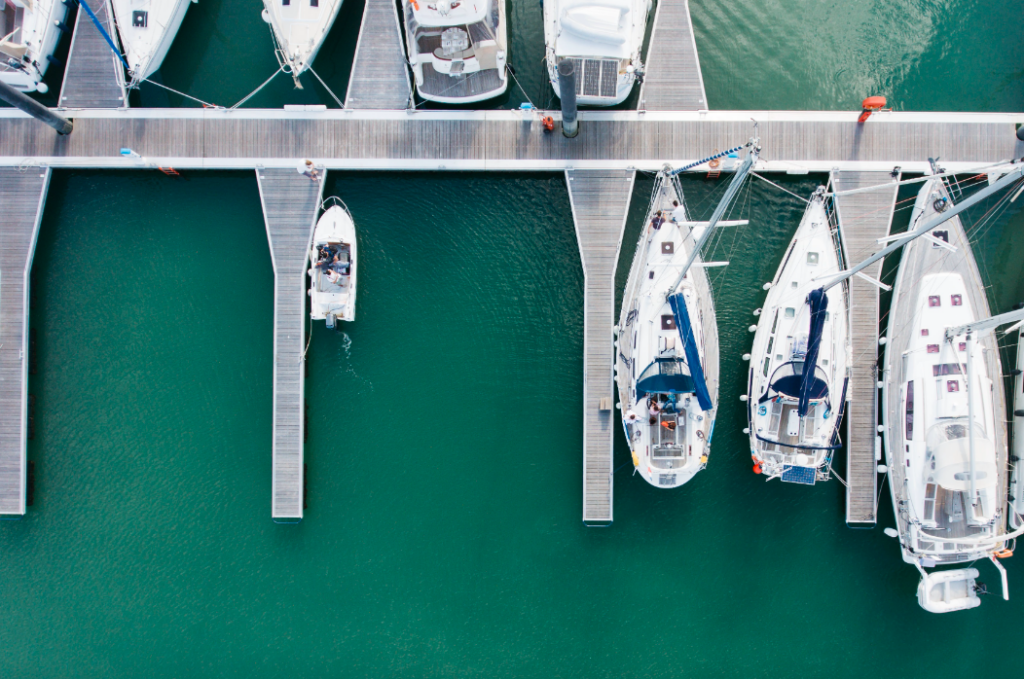
Essentially, in Williams’ system, a marine safety rope runs under the whaling of each arm, finger and floating walkway of a marina. When somebody has fallen into the water and grabbed onto the rope, a switch is triggered sending a signal to the base station releasing text messages out to pre-programmed numbers, ensuring that help is on the way.
The nearest dock alarm activates a siren and a bright led strobe of light. It’s also fitted with a Duress button, in case of on dock emergencies.
All switches and dock alarms are battery operated and closely monitored notifying the base station of battery levels, temperatures and any faults.
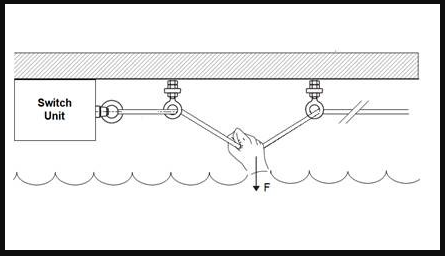

Williams says the business is currently focused on Australia (where there have been 23 drowning deaths at marinas between 1 July 2011 and 30 June 2022**) and New Zealand, but there are plans to possibly licence the patented system in Europe and the USA. A system has just completed a successful 12-month trial at Westhaven’s Z Pier.
“Until now life rings and the occasional ladders have ‘ticked the box’ so to speak for marina safety,” says Williams. “Our system has already proven its value in a life saved. If a marina wants to be serious about the safety of their staff and customers and possibly reducing their business risk profile then they should absolutely look at our system.”
Risk of accidental drowning in marinas
Merrimac Insurance says that the chance of accidental drowning looms over marina operations. Dockside hazards, slippery footing, and careless behaviour contribute to drownings each year. It cites slip, trip, and fall hazards, overboard hazards, swimming in marina waters, and lack of safety equipment (including life-rings, egress ladders, and signage/lighting on docks) as danger points.
It goes on to say that failure by marinas to implement safety practices to prevent drownings can result in tragedy and significant claims burdens on marina insurance policies.
But more than this, there’s another risk factor in marina operations, and that’s electric shock drowning (ESD). According to the Electric Shock Drowning Prevention Association, ESD is the result of the passage of a typically low-level AC current through the body with sufficient force to cause skeletal muscular paralysis, rendering the victim unable to help himself/herself, while immersed in water, eventually resulting in the victim drowning.
Electric Shock Drowning
The US-based organisation says the majority of ESD deaths have occurred in public and private marinas and docks. The typical victim, it says (although the figure it offers in its relevant statistics is ‘many’*) is a child swimming in or around a marina or dock where electricity is present. The electricity that enters the water and causes ESD originates from the wiring of the dock or marina, or from boats that are connected to the marina’s or dock’s power supply. If an electric fault occurs on a boat while it is connected to a marina’s or dock’s shore power and the boat or marina is not properly wired to meet current standards, the water surrounding the boat will become electrified.
Often, the electric fault occurring aboard the boat is intermittent. For example, the fault may only occur when a light switch is turned on, or when a hot water heater, battery charger, A/C unit or other electrical device cycles on. Water can appear and feel ‘safe’ and in a split second become deadly, says the association.
Merrimac Insurance says at the least marina owners must forbid swimming on marina properties and regularly inspect for hazards (like tripping hazards such as mooring lines, electrical cables, or loose dock planking). It says fuelling stations, boat lifts, sewage pumping facilities, shore power stations and dock lighting must all be checked as part of this work.
Main image courtesy of Premier Marinas. Aerial image of marina courtesy of Dek Technologies.
*In its FAQs, the Electric Shock Drowning Prevention Association says:
In the vast majority of ESD, the victim’s autopsy shows no signs of electrical injury and investigators often never learn that electricity was the cause of the drowning.
How many of these unexplainable drownings have likely been caused by Electric Shock Drowning instead of cramping, excessive alcohol use, or some other factor? The answer – many.
** Royal Life Saving Society – Australia, from the Royal Life Saving National Fatal Drowning Database


